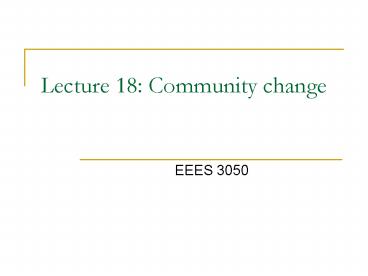Lecture 18: Community change - PowerPoint PPT Presentation
1 / 45
Title:
Lecture 18: Community change
Description:
Studied sand dune vegetation on the shores of Lake Michigan. ... Examples: abandoned farm field, flood, forest fire, disease/insect outbreak. regenerative: ... – PowerPoint PPT presentation
Number of Views:127
Avg rating:3.0/5.0
Title: Lecture 18: Community change
1
Lecture 18 Community change
- EEES 3050
2
Succession
- Succession
- Definition
- The process of directional change in vegetation
during ecological time. - Primary Succession
- Succession on new areas
- Secondary Succession
- The recovery of disturbed new sites.
3
(No Transcript)
4
Example Dune succession
- Henry Cowles (1899)
- Studied sand dune vegetation on the shores of
Lake Michigan. - Brief history of Lake Michigan Lake levels.
5
Historic Lake Levels
6
(No Transcript)
7
(No Transcript)
8
Example Dune succession
- ideal system for studying succession.
- Why?
- Same initial substrate.
- Same relief
- Same available flora and fauna.
- Thus, only differences between dunes should be
time, biological processes of succession, and
random events.
9
Example Dune succession
- Primary Assumption
- Exchanging space for time.
10
Stages of dune succession
- Bare soil
- Bare sand produced by drop of lake and blowouts
- Wind continually shifts sands.
11
(No Transcript)
12
Stages of dune succession
- 1) Bare soil
- Bare sand produced by drop of lake and blowouts
- Wind continually shifts sands.
- 2) Colonization
- Establishment of grasses (marram grass).
- Usually by rhizomes
- Likes moving sands
- Not found in areas after about 20 years.
13
(No Transcript)
14
Stages of dune succession
- 3) Colonization of additional grasses.
- Help stabilize dunes.
15
(No Transcript)
16
Stages of dune succession
- Colonization of additional grasses.
- Help stabilize dunes.
- 4) Colonization by woody species
- 1st usually cottonwoods
- Also willow and sand cherry.
- Dune becomes stabilized
17
(No Transcript)
18
Stages of dune succession
- 5) After stabilization
- Jack pine white pine
- 100 to 150 years later
- Black oak trees.
19
(No Transcript)
20
(No Transcript)
21
- What other systems can be used by exchanging time
with space? - Retreating glaciers.
- Examples of succession
- Old farm field
- Post-burn
- Tree gaps
- Volcanic lava flows
- Disease
- Human disturbance
22
Succession Happens How?
23
Succession an historical perspective.
- 4 major hypotheses
- Relay floristics/monoclimax hypothesis
- Initial floristic composition
- Tolerance Model
- Random colonization
24
Succession an historical perspective.
- Clements view Monoclimax Hypothesis
- Called relay floristics by Egler
25
- Clements view Monoclimax Hypothesis
- Key assumption
- Species replace each other through each stage
because they change the environment such that it
is more suitable for the next species. - Climax community in any region is determined by
climate.
26
Nature and Structure of the Climax by Frederic
Clements (1936)
- Has a category for everything!
- Climax state
- Proclimax
- Disclimax
- Subclimax
- Climax community definition
- Final or stable community in a successional
series. It is self-perpetuating and in
equilibrium with the physical and biotic
environments.
27
(No Transcript)
28
Succession
- Initial floristic composition
- Proposed by Elger (1954)
- Succession is heterogeneous.
- Development depends on who gets there first.
29
(No Transcript)
30
Succession
- Initial floristic composition
- Still species have no competitive advantage.
- Dominant community merely a matter of who gets
there first and lives the longest. - Succession proceeds from short-lived to
long-lived species.
31
Succession
- Tolerance model.
- Could lead to Tilmans resource ratio hypothesis.
- Species are replaced by other species that are
more tolerant of limiting resources.
32
- Random Colonization
33
- Random Colonization
- Succession involves only the chance survival of
different species and the random colonization by
new species. - Thoughts?
- Not a realistic scenario, but established a null
model to test against. - If not random, than some process must be at work.
34
Back to the dunes
35
(No Transcript)
36
What model fits the dune scenario?
- Monoclimax?
- Initial floristic composition?
- Tolerance?
- Random Colonization?
- We only examined the dominate species!
- Perhaps a mix of climax and random colonization.
37
Example 2 Glacier Bay
38
(No Transcript)
39
Glacier Bay Movie
40
Changes in pH
41
Changes in Nitrogen
42
Types of species
- pioneers (r-species)
- short-lived
- high reproduction
- poor competitors
- emphasize dispersal
- climax species (K-species)
- long-lived
- low reproduction
- strong competitors
- emphasize survival
43
Type of Succession
- primary
- new site, never before home to a community
- Examples ash flow, new sediments, retreat of
glacier - secondary
- disturbed site
- most common
- Examples abandoned farm field, flood, forest
fire, disease/insect outbreak. - regenerative
- replacement with same species
- Examples Periodic disturbance
44
Community Change
- Patch Dynamics
- Small-scale changes in a community
- Examples
- Degeneration of plants
- Tree fall gap
- Dispersal of organisms
- Wave action
- Burrowing animals
45
Treefall gap































